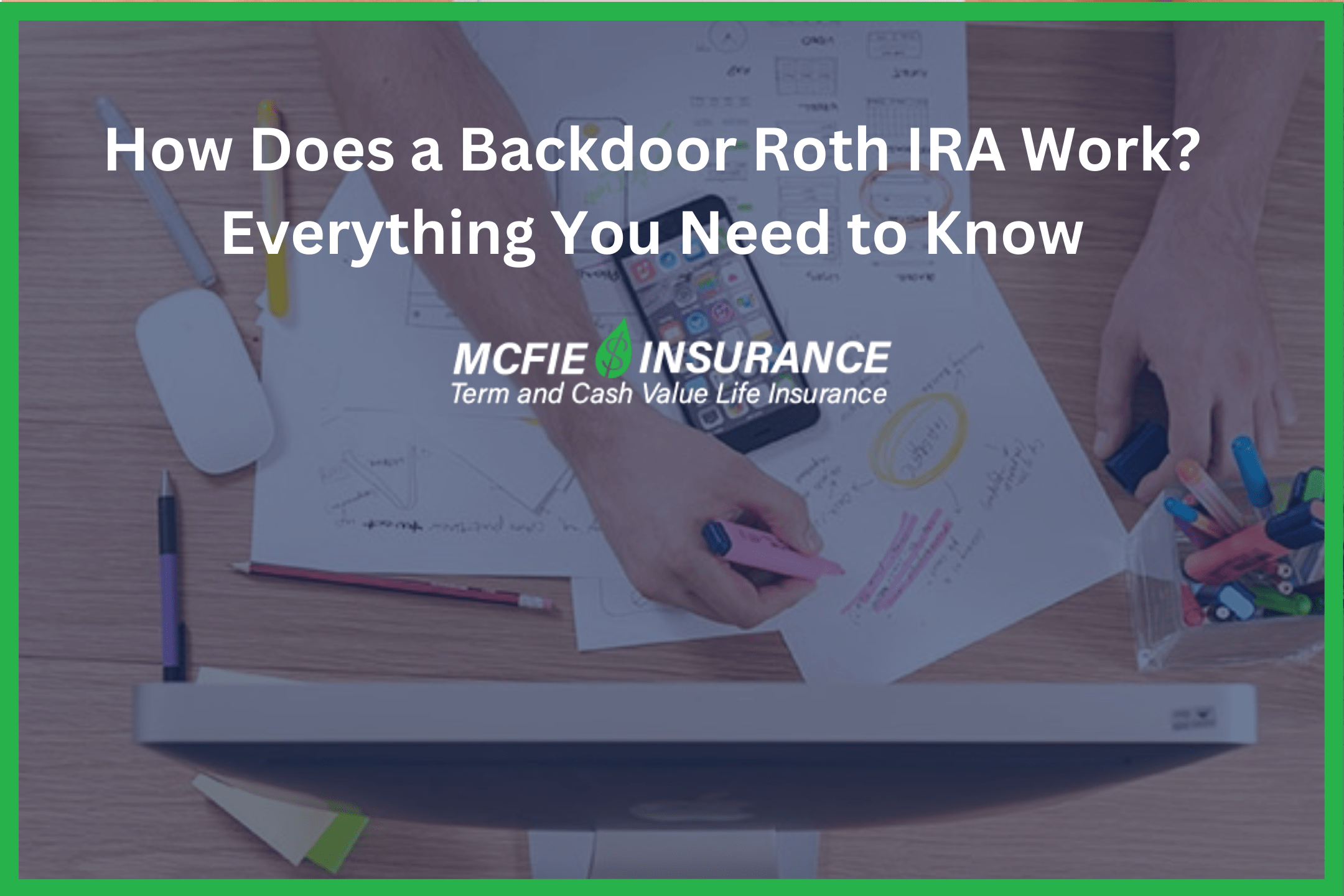702-660-7000
702-660-7000

A backdoor Roth IRA may sound like a special type of account, but it is a plain Roth IRA account funded through a rollover (or conversion) rather than by direct contributions. (see our podcast on what is a Roth IRA)
Once the account is set up, you can continue to make contributions just as you would to any other Roth IRA account, if your income allows.
Because the amount of a conversion to a Roth IRA is not considered a contribution, this is even a way for high-income earners to fund a Roth IRA which they would not be able to do through normal contributions.
Max Levchin and Peter Thiel, co-founders of PayPal, are prominent examples of high-income earners who have opted to fund Roth IRAs through a rollover from previous tax-qualified plans.
Starting a backdoor Roth IRA involves initially contributing to a traditional IRA through a nondeductible contribution, which is permissible regardless of income level, unlike Roth IRA contributions that have an income limit.
Then, the contribution made to the traditional IRA is converted into a Roth IRA. If there are no earnings on the amount being converted, this conversion does not incur taxes, contrary to the taxable event that occurs when converting pre-tax IRA funds to a Roth IRA, where taxes are due on the conversion at your current ordinary income tax rate.

Get the knowledge you need to build sustainable wealth, and have peace of mind about your financial future. Order here>
It’s also crucial to consider whether you’re qualified for direct Roth IRA contributions based on your modified adjusted gross income (MAGI) and your tax filing status (such as single, married filing jointly, or married filing separately), as this influences your direct contribution eligibility.
For the 2023 tax year, single filers must have a MAGI below $153,000, and for the 2024 tax year, below $161,000 to contribute to a Roth IRA. For married couples filing jointly, the MAGI limits are under $228,000 for 2023 and under $240,000 for 2024.
Should your MAGI surpass these thresholds based on your filing status, you might consider a backdoor Roth IRA conversion as a strategy for incorporating Roth IRA benefits into your retirement planning.
Growth on investments within a Roth IRA are 100% tax-free, so obviously the benefit to opening a backdoor IRA is the fact that you get unlimited growth going forward with no more taxes. Qualified withdrawals from a Roth IRA are also tax-free, and there are no required minimum distributions. This is huge.
When the investments you want to make are available within a Roth IRA, this strategy of rolling funds from an existing Traditional IRA, a 401(k), or another type of tax-qualified plan can work extremely well. Now for the downsides.
Basically, a backdoor Roth IRA conversion is about taking money from a pre-tax retirement account and converting it to an account that never pays taxes again. You will have to pay the taxes whenever you implement a Roth conversion, and there isn’t any way around this.
Starting a large backdoor Roth IRA all in one year may put you into a higher tax bracket. Plan ahead so you know what to expect and are sure you can pay the taxes.
Prior to the Tax Cuts and Jobs Act of 2017, it used to be possible to reverse part of a Roth IRA conversion if you discovered a mistake that put you into the next tax bracket or caused another problem. This was called a recharacterization, but it is no longer allowed.
One case where you may not have to pay taxes on a backdoor Roth IRA conversion is if the original contribution to a Traditional IRA was not tax-deductible in the first place. But then, you may have to pay income taxes on the gains or for another reason under the pro-rata rule.
Another case where you may not have to pay taxes on a Roth IRA conversion is if the funds are coming from a Roth 401(k) and all the funds involved in the conversion have already paid taxes.
Many states also charge income taxes on a Roth IRA conversion. Obviously, states with no income taxes are a non-issue, and there are also some states who will give you a full or partial tax-break if you are over a certain age.
Massachusetts, New Jersey, and Pennsylvania are special cases because they do not allow a tax deduction for contributions to a Traditional IRA, and thus have different rules on Roth conversions as well.
Be sure to check the rules in your state and maybe even talk with a tax advisor to make sure you fully recognize the state tax implications of starting a backdoor Roth IRA.

Understanding the Infinite Banking Concept and How It Works In Our Modern Environment 31-page eBook from McFie Insurance Order here>
If you have existing balances in other IRAs at the time you make a Roth IRA conversion, it may be harder to calculate your taxes.
The pro-rata rule uses the ratio of pre-tax money across all your Traditional IRA accounts divided by the entire balance of all your IRAs as of December 31st of the year you make the conversion. This ratio is used to determine the taxes you pay on a Roth conversion.
There can be other factors, but the basic formula looks like this:
Pre-Tax IRA Funds/Total IRA Funds = Taxable percentage of the conversion
For example:
If your income is high enough that you cannot contribute to a Roth IRA, and your income is also high enough that you do not get a tax deduction for contributing to a Traditional IRA, then you might think it would be a good idea to contribute 6,000 to a Traditional IRA, then turn around and do a Roth IRA conversion the same year.
Since you don’t get a tax deduction for the initial 6,000 contribution to your Traditional IRA, it is logical to think there might not be any further taxes when you do the Roth conversion. This can be true if you have no other Traditional IRAs.
But if you do have another Traditional IRA with a pre-tax balance of 100,000, then your 6,000 conversion will be considered a distribution from all your IRAs collectively, composed of pre-tax and after-tax dollars according to your pro-rata ratio.
Using the formula above, this would mean (100,000 /106,000 = 94.34%) of your 6,000 conversion (6,000 x 94.34% = 5,660.38) will be taxed again as you make the conversion.
SIMPLE IRAs and SEP IRAs are included in the calculation for the pro-rata rule, but not 401(k) plans unless you make a distribution or Roth conversion from a 401(k) in the same year.
As you can see, it is important to pay attention to the pro-rata rule whenever you are considering a backdoor Roth IRA and have other existing IRA accounts.
Whenever you perform a rollover to a Roth IRA, it’s important to follow the rules at the time of conversion and for 5 years beyond conversion.
First, you need to decide how the funds will be handled during the rollover process:
It’s important to know that if you have your custodian send a check, you cannot deposit this check into your bank account and then write a check to your new custodian.
If you make this mistake, the transaction will be considered a distribution rather than a conversion. You will still have to pay taxes and perhaps a 10% penalty but cannot put the funds into a Roth IRA after all.
This goes to show the importance of doing your planning before the conversion, because if you want to pay the taxes with money from the original plan, you may not be able to do so without facing a 10% penalty. This 10% penalty also extends to the money in your new backdoor Roth IRA through the 5-year rule.
If you are under age 59 ½ and you roll a tax-deferred plan to a backdoor Roth IRA, then you will also face a 10% penalty to access the money in the new Roth IRA anytime within the next 5-year period starting on January 1st of the calendar year you perform the rollover, or until age 59 ½ whichever is sooner.
If you’re over age 59 ½, you can safely ignore this rule.
Both Roth and Traditional IRAs are popular retirement savings options, offering the flexibility of self-directed investments and similar contribution limits. However, their primary distinction lies in the timing and treatment of their tax advantages.
Contributions to a Roth IRA are made with after-tax income, allowing the investments to grow tax-free, with the potential for tax- and penalty-free distributions after the age of 59½. In contrast, Traditional IRAs offer an immediate tax benefit by reducing your taxable income for the year of contribution. Contributions to a Traditional IRA are made with pre-tax dollars, and the withdrawals made after age 59½ are taxed as ordinary income.
A backdoor Roth IRA may be a good idea for people who don’t need to access their money for several years and wish to pay the taxes now so they can earn tax-free compound growth for the rest of their life.
If these candidates are under age 59 ½, they will also need to have funds available outside pre-tax plans to pay the taxes on the rollover. This is important to avoid the 10% penalty.
Even though people over age 59 ½ can take money out of a plan before or after conversion in order to pay taxes, they may also wish to have extra funds outside rollover plan to pay taxes. This allows them to maximize the Roth IRA balance for tax-free compounding.
Finally, the ideal candidate for a backdoor Roth IRA should be certain of getting a good return within the new plan after conversion, to make it worth paying the taxes all at once. If the investments in the new Roth IRA could lose money, it would be better to keep the assets in a tax-deferred plan.
If you’re already in a high-income tax bracket, or on the edge of the next income tax bracket, you should carefully consider whether it might not be better to do a Roth conversion in another year or to spread the conversion over several years.
Some people believe it is not worthwhile to do a Roth IRA conversion at all if you are in the 24% tax bracket or higher. This is very much dependent on whether you believe your income will remain high beyond the typical retirement age, or whether you think it will be lower, thereby putting you in a lower tax bracket.
If you are likely to be in a lower tax bracket in the future, it may make sense not to do a conversion from a high tax bracket, but this decision remains an educated guess at best.
Expected earnings are also a factor. Obviously comparing results on tax-deferred vs. tax-free accounts earning 4% or 12% will vary considerably. Anticipating a higher return might be worth paying higher taxes on the “seed” of your investment rather than the entire “harvest.”
Sticking with a pre-tax plan usually indicates a belief that you will be in a lower tax bracket in retirement, but it also leaves you at the mercy of possibly higher taxes in the future.
Finally, if you don’t have money outside your retirement plan(s) to pay the taxes and would face a 10% penalty for withdrawing funds to pay the taxes on a rollover, then a backdoor Roth IRA may not be a good idea for you.

Get a working knowledge of how each type of life insurance policy works.
After reading this 10-page booklet you'll know more about life insurance than most insurance agents.
Download here>
Taxes are obviously the biggest threat to growing wealth. If starting a backdoor Roth IRA will trigger a lot of taxes for you, and you know that you’ll be retiring in a few years with a level of income that will put you in a lower tax bracket, then starting a backdoor IRA doesn’t make much sense.
Also, if you are close to 59 ½ and have large balances in a pre-tax retirement plan, it may not make sense to do a Roth conversion if you’ll have to scramble to find the tax dollars to pay for the conversion.
Remember, you cannot access money from a Roth IRA after conversion or from your pre-tax retirement plan(s) before age 59 ½ without facing a 10% penalty.
One of the big downsides of a backdoor Roth IRA is the access to your money. Your original money will be locked away under a 10% penalty for 5 years or until age 59 ½ whichever is less. Earnings continue to be locked away until age 59 1/2.
Knowing this problem with access to money in a Roth IRA, many people choose to build a financial foundation through Whole Life Insurance where the cash values are always liquid and accessible.
Whole life insurance is very similar to a Roth IRA when it comes to tax treatment. Premiums are paid with after-tax dollars, just as contributions to a Roth IRA are made with after-tax dollars.
Cash values grow tax-deferred but can be accessed via policy loan without triggering the taxes. This is like a Roth IRA where contributions can be withdrawn after 5 years without triggering taxes. But you can’t get the money back into the Roth IRA.
The death benefit on a whole life insurance policy is 100% income tax-free, which is similar to leaving a Roth IRA to your heirs. Of course, the death benefit on a life insurance policy is guaranteed and usually starts out much higher than a Roth IRA account. This creates a nice element of protection.
Usually after 8-15 years, the cash value in a well-designed whole life insurance policy will exceed the total of all premiums paid, so at this point, the life insurance element becomes much less expensive than buying term insurance.
Many people fund life insurance premiums from their income. Others learn about whole life insurance later in life when they have already built considerable investments in tax-deferred retirement accounts.
Recognizing the value of a life insurance death benefit for passive income planning and legacy purposes, some people choose to fund a whole life insurance policy with funds from a retirement account, paying the taxes in a similar manner to performing a backdoor Roth IRA.
When you’re over age 59 ½ there is no 10% penalty and a policy can be funded over several years or with a lump sum going into a premium deposit fund with a life insurance company that covers the premiums for a certain time.
Cash values in life insurance can also be used to fund the taxes on a future backdoor Roth IRA. Many people work for companies that provide a 401(k) plan, and they may choose to make contributions to a 401(k) to get the employer match. (see Roth IRA vs. 401k)
When changing jobs or retiring from this position in the future, a window of opportunity for a backdoor Roth IRA opens. You can self-finance the taxes by taking a policy loan without touching the money accumulated in your 401(k) plan. This can make it easier to start a backdoor IRA before 59 ½ and even at a time when your income might be limited.
If you’re over age 59 ½, you could access money from the plan to pay the taxes, but this would decrease the balance of your new Roth IRA. Using a policy loan to pay the taxes, in this case, allows you to maximize the balance of your backdoor Roth IRA.
The policy loan can be paid back over time and now you have more money growing tax-free in the Roth IRA for the rest of your life.
Thinking about life insurance, brings up the question of how life insurance policies might fit into a retirement income strategy?
There are a few ways life insurance policies can play a role in retirement income:
Read more about these options in another article on retirement income strategy with life insurance.
Backdoor Roth IRAs can be a great way to invest money with tax-free growth for the rest of your life. Better liquidity can usually be achieved by using a system of whole life insurance policies as a source of liquidity and guarantees in combination with other invested accounts which may include a backdoor IRA.
Building life insurance into your portfolio can also help you leave a bigger legacy than you would normally be able to do through a Roth IRA alone because a certain amount of liquidity is always desired for resilience in meeting unexpected life events and acting on special opportunities.
At McFie Insurance, we specialize in designing Whole Life Insurance policies to maximize cash values and guarantees. Call us at 702-660-7000 and schedule a strategy session to see how the Life Benefits Formula® can work for you.
Here are some frequently asked questions about backdoor Roth IRAs.
Yes. Many people who cannot contribute to a Roth IRA because of high-income limitations, will contribute to a Traditional IRA and immediately rollover the contribution to their Roth IRA.
This can be a great strategy but be sure to pay attention to the pro-rata rule or you could end up paying more taxes.
It is too late to perform a Roth IRA conversion in 2024 and have it applied to the 2023 tax year because, unlike contributions, conversions must be applied to the tax year in which they occur.
Contributions to a Roth IRA for 2023 may still be made any time before the tax filing deadline, which is April 15th, 2024.
A Roth IRA is a retirement savings account that permits tax-free distributions during retirement. Contributions are made with after-tax income, subject to an annual maximum. In 2024, the contribution ceiling is $161,000 for individuals and $240,000 for married couples filing together.
A backdoor Roth IRA provides a workaround for individuals whose earnings exceed the Roth IRA income thresholds, enabling them to convert contributions from a traditional IRA (which were not tax-deductible) into a Roth IRA. This conversion process typically involves paying income taxes on the amounts transferred to the Roth IRA that haven’t been taxed yet.
If your income allows you to contribute to a Roth IRA directly, it may not be worth jumping through the extra regulations simply to put the same contribution into a Traditional IRA first and then roll it over to a Roth IRA.
If you have accumulated money in a Traditional IRA or other types of retirement plans, it may be worth looking at a backdoor IRA to avoid future taxes.
A mega backdoor Roth IRA is a strategy that permits individuals with high incomes, whose modified adjusted gross income (MAGI) exceeds the limits for traditional Roth IRA contributions, to transfer funds from a 401(k) to either a Roth IRA or a Roth 401(k). In 2024, this method allows for a conversion of up to $46,500 from a traditional 401(k) into a Roth setup.
To utilize a mega backdoor Roth, certain criteria must be met:
– Your workplace 401(k) plan must accept after-tax contributions, which differ from the standard pre-tax contributions made to traditional 401(k) plans. It’s important to note that less than half of 401(k) plans offer this option, so verification with your benefits administrator is essential.
– The plan must also permit in-service withdrawals to a Roth IRA or the transfer of after-tax contributions directly into a Roth 401(k). Without this provision, the mega backdoor Roth conversion must be deferred until employment termination.
Many people believe the taxes on a backdoor Roth IRA are not worth the effort when you’re already in a high tax bracket. This thought process is based on the theory that most people will be in a lower tax bracket when they retire. While this may be true for some people it is certainly not true for everyone. Basically, you are deciding on whether to pay taxes today and never pay taxes on the account again or continuing to defer the taxes today and hope that taxes will be lower in the future.
Liquidity is another consideration. Why would you lock money into an account if you might need it soon? Read more about liquidity in the section on whole life insurance.
The choice is yours. Don’t assume that one way is automatically better simply because someone else made a comparison. Do your own research so you can make an informed decision.
Under the Tax Cuts and Jobs Act of 2017, income tax rates are lower for most Americans than they have been in recent years. After 2025 many of the provisions from this act, including lower tax rates expire and go back to pre-2018 levels.
If you wish to start a backdoor Roth IRA, the remaining time window from 2024-2025 may be very important to you. Large pre-tax accounts can be converted over the next year to help keep you in a lower tax bracket.
No one knows for sure where taxes will go after 2025, but this could be a way to save taxes while rates are relatively low.
 by John T. McFie
by John T. McFie
I am a licensed life insurance agent, and co-host of the Wealth Talks podcast.
At age 14 I started developing spreadsheet models and software systems to help my Dad share financial concepts with clients.
Skipped college at 17 recognizing the overinflated value and prices of most college degrees and built more financial software instead (see MoneyTools.net). Still a strong advocate of higher education without going to college. I enjoy making financial strategies clear and working through the numbers to prove results you can count upon.